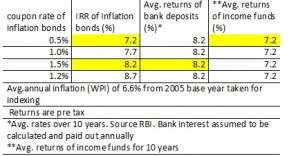The much-awaited government bonds that seek to protect you from inflation is all set to be issued. Called inflation indexed bonds (IIB), these bonds will carry a fixed coupon rate (interest rate); the rate is not known presently.
Your interest will be calculated on inflation-adjusted principal . And to top it, you will receive the inflation-adjusted principal or face value, whichever is higher, at the time of maturity.
Do take a look at Deepak Shenoy’s article to know about IIB and how the interest on these bonds will be calculated: http://ow.ly/l7sgI
Now, there are many unanswered questions at this point in time about these bonds. Will you need a demat account?; how will it be taxed?; who can buy?; and most importantly what will be the coupon rate?

When they turn attractive
We tried to look at the last point first. After all, it is the coupon rate that will decide whether this product is going to win over your fixed deposits and debt mutual funds, inflation being the variable factor.
Consider the data below. We have the Internal rate of return (IRR) of inflation indexed bonds and the average returns of other debt classes. Here, the bank interest and bond interest are calculated as annual payout for the sake of simplicity. Mutual fund returns are on a cumulative basis (as is the general norm to look at the returns from this product). Agreed, that funds may therefore not be strictly comparable with the other two. Still, it provides a ball park.

For a 10-year IIB, with a 6.6% average inflation, the coupon rate has to be just 1.55% (pre-tax) to return as much as bank deposits. It has to be an even lesser 0.5% to beat the 10-year category-average of income funds. Anything above this will mean IIB will likely deliver better.
Of course, in this, the tax treatment could change the decision-making process for each of you. As popular opinion goes, it is likely that interest income from IIBs is taxed at your slab rate while the adjusted principal may receive indexation benefits. On the face of it, tax treatment may be superior to bank deposits.
What it means to you
1. As we see it, the coupon rate on these instruments cannot be high. Imagine having an inflation of say 7% and a coupon rate of 8% to top it. Now that’s something the government cannot afford to pay you. So, be prepared for some low coupon rate. Yet, get your numbers right and do not write-off the low coupon rate in a jiffy.
- The inflation adjustment done to your capital will be received as money by you only at the end of the tenure. But remember, the interest income that you receive every year will be higher exactly by the inflation amount. So this may turn out to be a good option for people, especially the retired, looking for steady cash flows that will also keep pace with inflation.
That said, if the bond has no cumulative option (it does not seem to, as the press release says interest will be paid out), then the product may not be great for those looking to build wealth for future goals; you would simply lose out on the benefit of compounding.
- Don’t forget that institutional investors, including mutual funds, can hold these bonds. Hence, a good way to actually bypass the tax issue and also use the benefit of accrual may be to seek out mutual funds that hold these bonds.
-
As things stand, the indexing is done based on WPI. Hence do not expect the bond to cover your real cost of living reflected in the consumer price index. That means, these bonds may only partially cover your price rise.
-
Finally, for now, inflation need not climb at the raging pace at which it did past couple of years. Hence, to depend on inflation to make your bond deliver returns, may not be a safe idea.
We will look at the finer details, as they emerge, to let you know how best you can make use of this product.







Although IIBs are being introduced to wean away people from investing in gold, it may not serve that purpose. Having said that, it does look like it will help in offsetting inflation to some extent. Especially point 3 of the article is to be noted. It may very well turn out to be a good package with the all-important feel of secure investment option.
Although IIBs are being introduced to wean away people from investing in gold, it may not serve that purpose. Having said that, it does look like it will help in offsetting inflation to some extent. Especially point 3 of the article is to be noted. It may very well turn out to be a good package with the all-important feel of secure investment option.
Hi Vidya,
Thanks for the article. Would it be possible for you to corroborate the pictorical representation of IIB,FD etc with some numbers how you came at it. 8.2 kind figure.
Hi Rohit. Thanks for writing in.
For the FD, the rate is just the simple average FD rate (for FD over 5 years) in the last 10 years as dislosed by RBI (RBI takes only 3-4 largest banks for this purpose). For sake of simplicity, the FD rate is taken to be annual payout and calculated annually.
For the IIB, it is nothing but the IRR calculation assuming the various coupon rate scenarios and the 6.6% avg. inflation rate. That means there is a cash outflow in year zero, year 1 to 9 will have cash inflows (which will be the interest on adjusted principal every year) and year 10 will be cash inflow of adjusted principal plus that year’s interest rate. All returns are pre tax as the tax treatment was not clear at the time of writing this article. Hope this helps. Tks, Vidya
Hi Vidya,
Thanks for the article. Would it be possible for you to corroborate the pictorical representation of IIB,FD etc with some numbers how you came at it. 8.2 kind figure.
Hi Rohit. Thanks for writing in.
For the FD, the rate is just the simple average FD rate (for FD over 5 years) in the last 10 years as dislosed by RBI (RBI takes only 3-4 largest banks for this purpose). For sake of simplicity, the FD rate is taken to be annual payout and calculated annually.
For the IIB, it is nothing but the IRR calculation assuming the various coupon rate scenarios and the 6.6% avg. inflation rate. That means there is a cash outflow in year zero, year 1 to 9 will have cash inflows (which will be the interest on adjusted principal every year) and year 10 will be cash inflow of adjusted principal plus that year’s interest rate. All returns are pre tax as the tax treatment was not clear at the time of writing this article. Hope this helps. Tks, Vidya
Prima facie, inflation-indexed bonds are not appearing to be attracted for investment for reasonable gain. The concept is also not fully clear and disclosed. I am in agreement of the above view of RupyaGyan to the extent “Although IIBs are being introduced to wean away people from investing in gold, it may not serve that purpose.”.
From: Sudhir Kapoor.
Prima facie, inflation-indexed bonds are not appearing to be attracted for investment for reasonable gain. The concept is also not fully clear and disclosed. I am in agreement of the above view of RupyaGyan to the extent “Although IIBs are being introduced to wean away people from investing in gold, it may not serve that purpose.”.
From: Sudhir Kapoor.